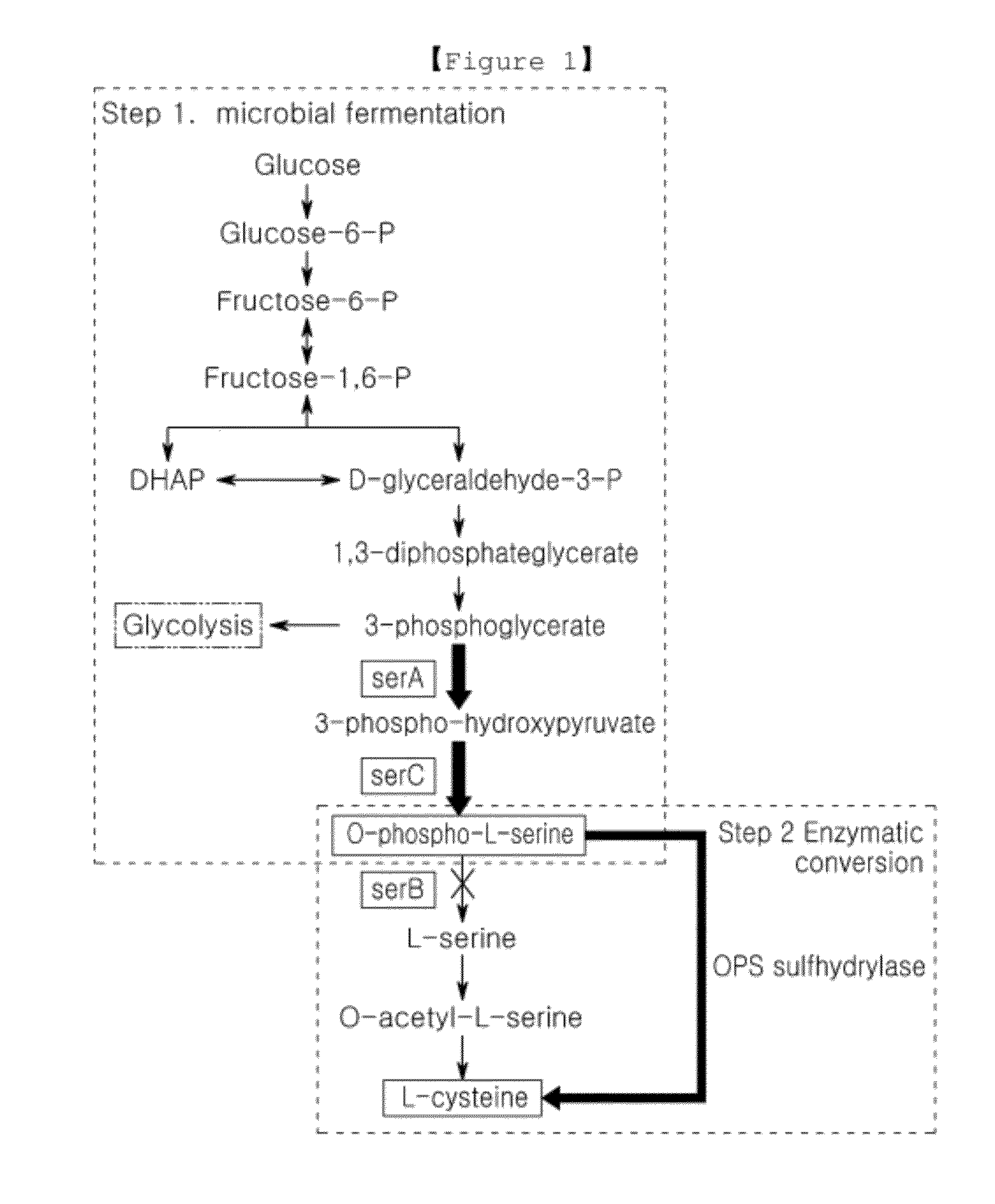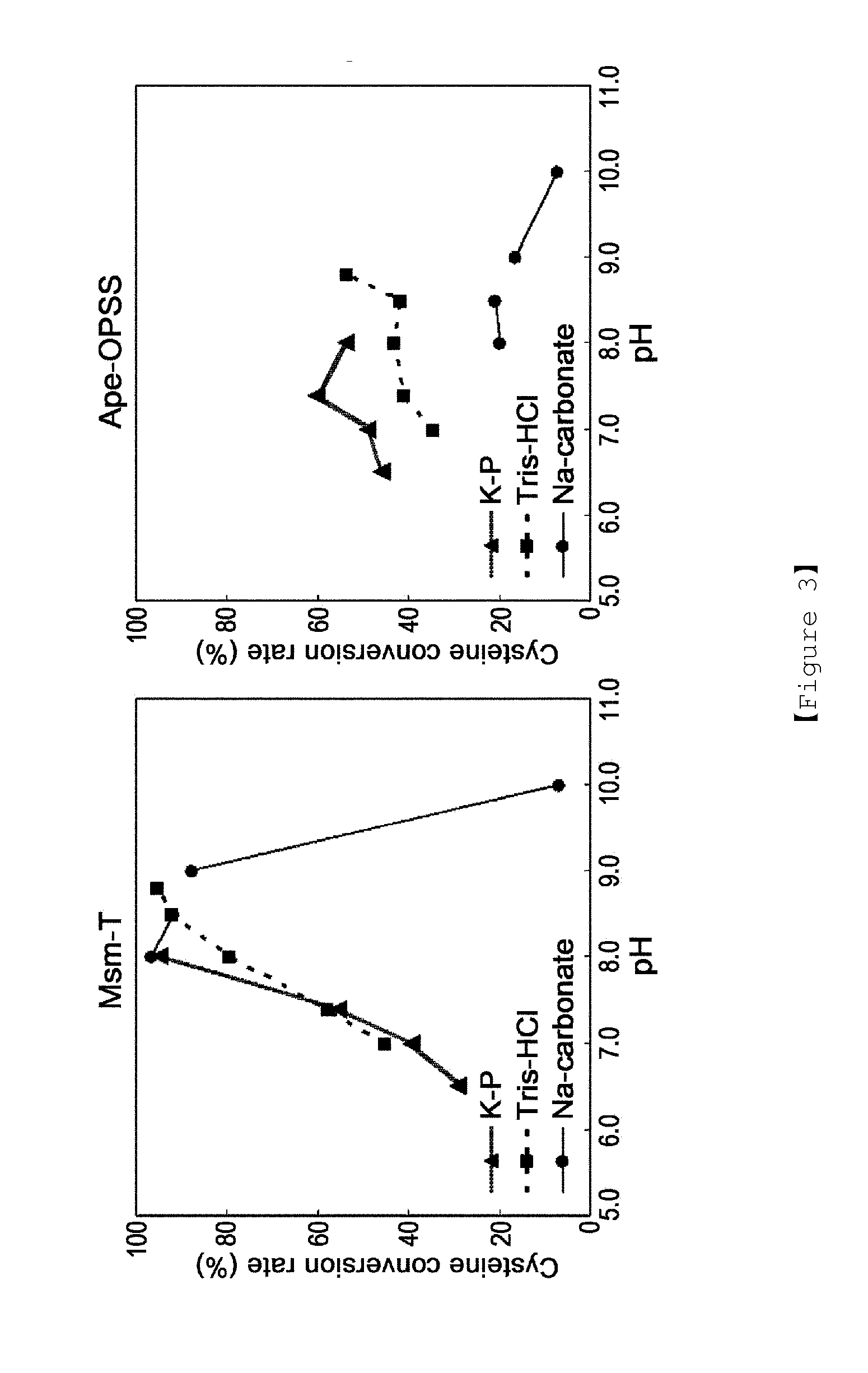Microorganism producing o-phosphoserine and method of producing l-cysteine or derivatives thereof from o-phosphoserine using the same
a technology of o-phosphoserine and microorganisms, which is applied in the direction of enzymology, microorganisms, transferases, etc., can solve the problems of difficult industrial application of the conversion process, environmental pollution, and excessive accumulation of l-cysteine within microorganisms, and achieves high yield and higher production efficiency
- Summary
- Abstract
- Description
- Claims
- Application Information
AI Technical Summary
Benefits of technology
Problems solved by technology
Method used
Image
Examples
example 1
Preparation of Phosphoserine Phosphatase (serB) Deficient Corynebacterium Strain
[0052]Corynebacterium glutamicum 13032 was modified by deleting the serB gene (SEQ ID NO: 13, EC 3.1.3.3) encoding phosphoserine phosphatase, which catalyses the synthesis of L-serine from O-phosphoserine, therefrom. To this end, a fragment for inactivation of serB was constructed. In this regard, primers were designed for the preparation of the recombinant strain 13032-ΔserB of the present invention. First, the serB sequence of Corynebacterium glutamicum 13032 was obtained with reference to the data of the NIH GenBank, and primers SEQ ID NOS: 22 to 27 were synthesized on the basis of the serB sequence. For the site-specific gene disruption, a pDC vector which cannot replicate in Corynebacterium glutamicum was employed. A pDC-ΔserB plasmid in which the open reading frame of serB was internally disrupted was constructed and adopted for the preparation of a site-specific serB gene deletion in Corynebacteri...
example 2
Assay for O-Phosphoserine Productivity in the Phosphoserine Phosphatase Deficient Corynebacterium Strain
[0054]The mutant strain CB01-0047, resulting from the deletion of serB from Corynebacterium glutamicum 13032, which was anticipated to accumulate O-phosphoserine, was spread over BHIS plates and incubated overnight in a 30° C. incubator. Afterwards, the colonies appearing on the BHIS plates were inoculated in 25 mL of a titer medium shown in Table 1 using a platinum loop and then incubated at 30° C. for 48 hours with shaking at 200 rpm. The results are summarized in Table 2, below.
TABLE 1CompositionAmount (per liter)Glucose100gKH2PO41.1g(NH4)2SO445gMgSO4•7H2O1.2gHSM20gTrace elements20mlCalcium carbonate30gpH7.2Trace elementsBiotin0.09gThiamine0.45gCa-Panthenate0.45gNCA3gFeSO4•7H2O9gMnSO4•4H2O9gZnSO4•7H2O0.045gCuSO4•5H2O0.045g
TABLE 2Sugar consumedO-phosphoserineStrainOD 562 nm(g / L)(g / L)C. glutamicum251000.0213032CB01-00476.5230.07
[0055]The CB01-0047 strain was observed to grow very...
example 3
Construction of Mutated Phosphoglycerate Dehydrogenase (SerA*) Gene Derived from Corynebacterium
[0056]The Corynebacterium glutamicum-derived genes serA*(E235K) (SEQ ID NO: 14) and serA*(197Δ) (SEQ ID NO: 15) were constructed, which encode respective mutants of 3-phosphoglycerate dehydrogenase, an enzyme catalyzing the synthesis of 3-phosphohydroxypyruvate from 3-phosphoglycerate. The mutants were reported to be feedback resistant (FBR) to serine (Peters-Wendisch P et al., Appl. Microbiol. Biotechnol., 60: 437-441, 2002; EP0943687B). serA*(E235K) was obtained by sewing PCR on the genomic DNA of ATCC13032 using primers of SEQ ID NOS: 28 to 31 while serA*(197Δ) was constructed by PCR using pairs of primers of SEQ ID NOS: 28 to 32. The PCR products thus obtained were inserted into respective T vectors to construct recombinant vectors called Tblunt-serA*(E235K) and Tblunt-serA*(197Δ). Subsequently, the two vectors were treated with restriction enzymes EcoRV and XbaI to give two DNA frag...
PUM
| Property | Measurement | Unit |
|---|---|---|
| temperature | aaaaa | aaaaa |
| temperature | aaaaa | aaaaa |
| temperature | aaaaa | aaaaa |
Abstract
Description
Claims
Application Information
 Login to View More
Login to View More - R&D
- Intellectual Property
- Life Sciences
- Materials
- Tech Scout
- Unparalleled Data Quality
- Higher Quality Content
- 60% Fewer Hallucinations
Browse by: Latest US Patents, China's latest patents, Technical Efficacy Thesaurus, Application Domain, Technology Topic, Popular Technical Reports.
© 2025 PatSnap. All rights reserved.Legal|Privacy policy|Modern Slavery Act Transparency Statement|Sitemap|About US| Contact US: help@patsnap.com



